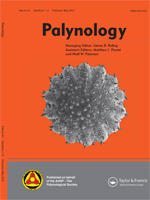The Khorat Plateau, at the centre of mainland Southeast Asia, is considered a bridge connecting the biotas of Indochina and Kalimantan. The vegetation change in this area is an indicator of regional environmental change, but the history is unclear. In this study, a sand pit along an ancient fluvial terrace on this plateau was investigated palynologically. An assemblage of Abies, Pinus, Chenopodiaceae and grass suggest a temperate forest and subtropical savannah 172,739 ± 22,400 and 88,661 ± 10,600 a BP, indicating a cold and dry environment. Deciduous and mixed forests indicate a warm period from 52,296 ± 6800 to 28,150 ± 7860 a BP, accompanied by aquatic components. An increase in mangrove abundance coincided with a rise in sea level. The period 27,332 ± 3000 a BP experienced a dry, cold environment. Conclusively, pollen records from the river terrace suggest tremendous vegetation change in the history of the Khorat Plateau.
How to translate text using browser tools
1 April 2018
Riverine Vegetation and Environments of a Late Pleistocene River Terrace, Khorat Plateau, Southeast Asia
Feng-Chun Yang,
Paul J. Grote
ACCESS THE FULL ARTICLE
It is not available for individual sale.
This article is only available to subscribers.
It is not available for individual sale.
It is not available for individual sale.

Palynology
Vol. 42 • No. 2
May 2018
Vol. 42 • No. 2
May 2018
Khorat Plateau
Late Pleistocene
Mun River
pollen
vegetation




